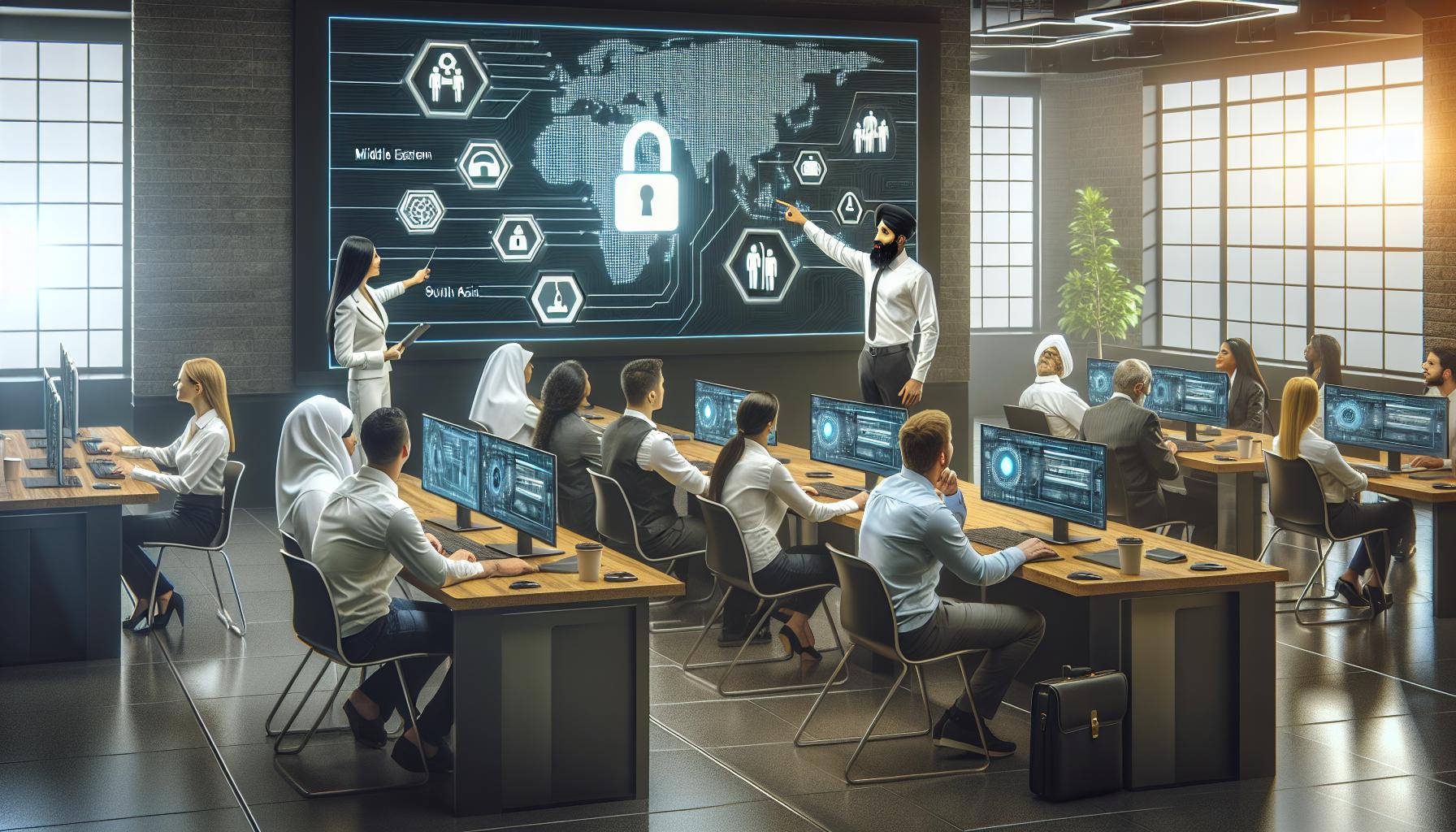Key Takeaways
- Prioritize Risk Assessment: Regularly evaluate vulnerabilities in your systems to identify potential threats and allocate resources effectively.
- Establish Comprehensive Security Policies: Develop and communicate clear policies regarding data handling and access to foster a culture of security awareness among employees.
- Implement Incident Response Plans: Prepare for security breaches with well-defined protocols to minimize damage and ensure swift recovery.
- Enhance Employee Training: Regular training initiatives help employees recognize threats like phishing, reinforcing overall organizational security.
- Adopt Advanced Security Technologies: Utilize firewalls, intrusion detection systems, and multi-factor authentication to safeguard networks and sensitive data.
- Stay Compliant with Regulations: Ensure your security measures align with legal standards like GDPR and HIPAA to avoid penalties and protect your organization’s reputation.
In today’s digital landscape, IT security management has become a critical priority for organizations of all sizes. With cyber threats evolving rapidly, businesses must adopt robust strategies to protect sensitive data and maintain operational integrity. Effective security management not only safeguards information but also builds trust with clients and partners.
As technology advances, so do the tactics of cybercriminals. Organizations face the challenge of staying one step ahead while managing resources efficiently. This article explores the key components of IT security management, offering insights into best practices and emerging trends. Understanding these elements is essential for any organization looking to fortify its defenses in an increasingly interconnected world.
IT Security Management
IT security management encompasses the policies, procedures, and technologies organizations use to protect their information systems from unauthorized access, attacks, and damage. It involves identifying security risks, implementing preventive measures, and establishing protocols for responding to incidents.
Key components of IT security management include:
- Risk Assessment: Organizations evaluate vulnerabilities in their systems and processes. This assessment identifies potential threats, enabling professionals to prioritize which areas require more stringent security controls.
- Security Policies: Developing comprehensive security policies guides employee behavior regarding data handling and system access. Policies outline acceptable use, password management, and data classification.
- Access Control: Limiting access to sensitive information ensures that only authorized users can view, modify, or delete data. Strong identity verification methods, such as multi-factor authentication, bolster access control measures.
- Incident Response Planning: A robust incident response plan prepares organizations for potential security breaches. The plan outlines steps for detecting, analyzing, and responding to security incidents, minimizing damage and recovery time.
- Security Training and Awareness: Employee training programs foster a culture of security within organizations. Regular training sessions promote awareness about phishing attacks, social engineering, and other threats.
- Compliance Management: Organizations must adhere to regulatory standards such as GDPR, HIPAA, or PCI DSS. Compliance management ensures that security measures align with legal requirements, protecting both data and corporate reputation.
- Continuous Monitoring: Implementing ongoing monitoring of systems helps detect unusual activity in real time. Security Information and Event Management (SIEM) solutions collect and analyze data logs, providing alerts for potential security incidents.
IT security management is an ongoing process requiring constant evaluation and adaptation. As cyber threats evolve, organizations must refine their strategies to safeguard critical data and maintain operational integrity.
Key Components of IT Security Management

Effective IT security management relies on several key components that work in tandem to protect organizational assets. These components play a vital role in identifying vulnerabilities, establishing protocols, and preparing for potential incidents.
Risk Assessment
Risk assessment involves identifying, evaluating, and prioritizing risks to information systems. Organizations conduct risk assessments through methods like vulnerability scans, threat modeling, and employee interviews. Risks categorized as high require immediate attention, while those deemed low may be monitored over time. Effective risk assessment informs decision-making, resource allocation, and strengthens overall security posture by enabling proactive measures against identified threats
Policy development focuses on creating comprehensive security policies tailored to organizational needs. Such policies govern the conduct of employees, define acceptable use of technology, and outline consequences for breaches. Regularly reviewing and updating these policies ensures alignment with evolving regulatory requirements and technological advancements. Clear communication of policies through training sessions promotes adherence among staff, reinforcing a culture of security awareness within the organization.
Incident Response
Incident response establishes protocols for identifying, managing, and mitigating cybersecurity incidents. Organizations develop incident response plans detailing roles, responsibilities, and communication strategies during an incident. Regularly testing these plans through tabletop exercises enhances readiness. Swift incident response minimizes damage, reduces recovery time, and helps maintain client trust. Depending on the severity, incidents may also trigger legal, regulatory, or public relations actions, underscoring the need for a structured approach to incident management.
Best Practices in IT Security Management

Effective IT security management incorporates best practices that strengthen defenses against emerging threats. Organizations must prioritize ongoing training and the deployment of advanced security technologies.
Regular Training and Awareness
Regular training enhances employee awareness of security protocols and potential threats. Organizations should implement mandatory cybersecurity training programs, covering topics like phishing recognition and password security. Frequent refresher courses help reinforce knowledge and address evolving cyber threats. Scheduled simulations of phishing attacks provide practical experience, enabling employees to identify real threats effectively. Cultivating a security-centric culture requires continuous communication and updates on security practices.
Implementation of Security Technologies
Implementation of robust security technologies significantly reduces vulnerabilities. Organizations should deploy firewalls, intrusion detection systems, and endpoint protection to safeguard networks. Regular software updates and patch management prevent exploitation of known vulnerabilities. Data encryption protects sensitive information both at rest and in transit. Multi-factor authentication (MFA) adds an additional layer of security, ensuring only authorized users gain access to critical systems. Regular security assessments and audits enable organizations to identify gaps in their security posture, allowing for proactive remediation measures.
Challenges in IT Security Management

Organizations face numerous challenges in IT security management, particularly in adapting to ever-changing threats and maintaining compliance with regulations. Understanding these challenges is crucial for developing effective strategies.
Evolving Threat Landscape
Cyber threats evolve continuously, necessitating organizations to stay vigilant and adapt their security protocols. Ransomware attacks surged by 151% in 2020, demonstrating the urgency for robust defenses. Attack vectors such as phishing and zero-day exploits become increasingly sophisticated, making it difficult for traditional security measures to keep pace. Organizations must implement threat intelligence solutions to gain insights into emerging risks and enhance their proactive defenses. Regular security assessments and penetration testing contribute to identifying vulnerabilities, enabling timely mitigation.
Compliance and Regulatory Issues
Compliance with industry regulations poses significant challenges for many organizations. Legislative frameworks, such as GDPR and HIPAA, impose stringent requirements for data protection and privacy. Failing to comply can result in severe penalties, including fines and reputational damage. Organizations must navigate complex compliance landscapes, ensuring security policies align with current regulations. Developing comprehensive documentation and conducting regular audits are vital steps for demonstrating compliance. Training employees on compliance-related matters also enhances overall security awareness. Engaging legal and compliance experts can further streamline this process and ensure adherence to evolving standards.
Future Trends in IT Security Management
Organizations are pivoting toward multiple future trends in IT security management to combat persistent cyber threats. These trends include increased automation, integration of artificial intelligence (AI), and a focus on zero-trust security models.
- Increased Automation: IT security management is leveraging automation tools for quicker detection and response. Automated threat detection systems reduce response times during security incidents, enabling teams to address vulnerabilities proactively.
- Artificial Intelligence Integration: AI is playing a crucial role in analyzing massive data sets for patterns indicative of potential threats. AI-driven analytics can enhance both threat detection and incident response, significantly improving overall cybersecurity efficiency.
- Zero-Trust Security Models: Implementing zero-trust architecture emphasizes verification and continuous monitoring. This approach assumes that threats may exist both inside and outside the organization, necessitating strict access controls and constant validation of user identities.
- Cloud Security Enhancements: As organizations migrate to cloud services, securing these platforms emerges as a priority. Hybrid and multi-cloud environments compel businesses to adopt rigorous security protocols, including data encryption and robust access controls.
- Focus on Compliance and Regulatory Adaptation: Compliance remains critical in ensuring that organizations adhere to evolving data protection laws. Strategies for maintaining alignment with regulations like GDPR and HIPAA are increasingly prioritized alongside security practices.
- Employee Training and Awareness: Continuous training programs are becoming imperative in safeguarding organizations against human errors. Awareness initiatives that focus on recognizing social engineering tactics and safe online behaviors augment overall security resilience.
- Collaboration Between IT and Security Teams: Cross-departmental collaboration enhances the security posture. Synchronizing efforts between IT operations and cybersecurity teams enables a holistic approach to managing security risk across the organization.
- Threat Intelligence Sharing: Information sharing among organizations and industry groups fosters a collective defense against cyber threats. Collaborative efforts to exchange indicators of compromise (IOCs) and threat intelligence improve capabilities to preemptively address emerging vulnerabilities.
These trends represent a significant shift in IT security management. By adapting to these evolving strategies, organizations enhance their ability to protect sensitive information while navigating an increasingly complex digital landscape.
Policy Development
Effective IT security management is crucial for organizations navigating today’s complex digital landscape. By prioritizing risk assessment and implementing robust security policies, businesses can significantly enhance their defenses against evolving threats. Continuous employee training and the adoption of advanced technologies further strengthen their security posture.
As cyber threats become more sophisticated, organizations must remain adaptable and proactive. Embracing trends like automation and zero-trust models will not only improve threat detection but also foster a culture of security awareness. With a commitment to ongoing evaluation and compliance, businesses can safeguard their sensitive data and maintain operational integrity.

